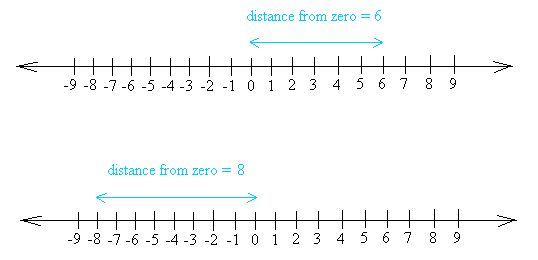Definition of Absolute Value
Definition of absolute value: The absolute value of a number is the distance the number is from zero. Take a look at the following two graphs:
Then, the absolute value of 6 is 6 and we write |6| = 6
The second graph shows -8 located at a distance of 8 units from zero.
Then, the absolute value of -8 is 8 and we write |-8| = 8.
You can see from this that the absolute value of a number is always positive with the exception of taking the absolute value of 0 (|0| = 0)
|6| means distance from 0 to 6.
|-8| means distance from 0 to -8.
For |-8| = 8, you could also argue that to get 8, you have to take the negative of -8 since - - 8 = 8
So, | - 8| = - - 8 = 8.
This observation helps us to come up with a formal definition of absolute value.
| x | = x if x is positive or zero, but -x if x is negative.
This definition is important to understand before solving absolute value equations or absolute value inequalities.
Other examples helping us to apply the definition of absolute value
Calculate the absolute value of the following numerical expressions.1) -8 + 2 × 5
2) 42 − 4 × 2
3) -5 + 5 × 2 − 15
1)
| -8 + 2 × 5 | = | -8 + 10 |
| -8 + 2 × 5 | = | 2 |
| -8 + 2 × 5 | = 2
2)
| 42 − 4 × 2| = | 16 − 4 × 2|
| 42 − 4 × 2| = | 16 − 8|
| 42 − 4 × 2| = | 8 |
| 42 − 4 × 2| = 8
3)
|-5 + 5 × 2 − 15| = | -5 + 10 − 15 |
|(-5 + 5 × 2 − 15)| = | 5 − 15 |
|(-5 + 5 × 2 − 15)| = | -10 |
|(-5 + 5 × 2 − 15)| = 10